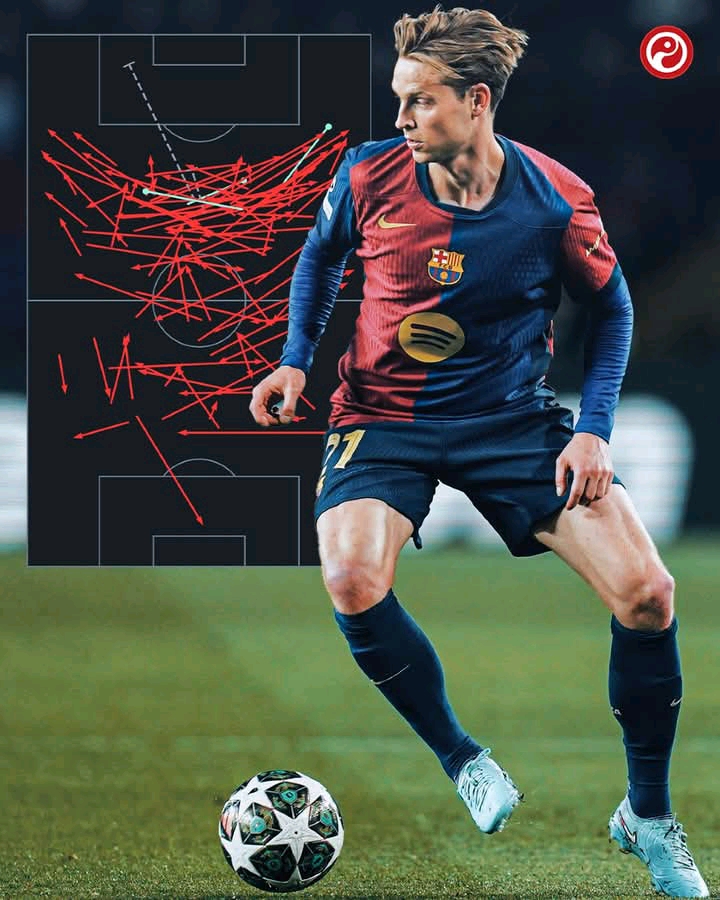It wasn’t just the goals. It was the spaces. The hesitations. The tactical misfires that let Barcelona dance around Inter Milan in a game that promised balance but quickly tilted under pressure. From the first whistle, it was clear that one team had come prepared to execute a blueprint, and the other was caught chasing shadows.
BREAKING DOWN INTER’S FORMATION:
Inter’s 3-5-2 shape was meant to suffocate midfield, clog passing lanes, and dictate rhythm through the experience of Calhanoglu, Barella, and Mkhitaryan. But when the wide men aren’t doing their job, that system falls apart. Dimarco, especially, was the weak link. Tasked with shadowing Lamine Yamal, he failed to track the 17-year-old, who found joy and freedom on the right. That one crack in Inter’s wall stretched the whole structure. Yamal pulled Acerbi wide again and again, creating gaps others didn’t cover. Dumfries did his job on Raphinha, but Dimarco’s lapse forced Inzaghi to call on Carlos Augusto to stop the bleeding.
BREAKING DOWN BARCELONA’S FORMATION:
Barcelona, meanwhile, didn’t stick to a rigid formation. Their 4-3-3 morphed into a 2-3-5 in possession. The idea was to flood forward, create superiorities in wide areas, and drag Inter out of shape. It worked. With Cubarsi and Martinez holding the backline, the real attacking threat came from how fluid the midfield and wide attackers moved. Pedri, in particular, was a problem Inter never solved. Calhanoglu was supposed to press him early and often. He didn’t. Pedri turned, twisted, wriggled out of pressure and launched wave after wave of attacks. That’s what press-resistant looks like.
When Gavi came on, things shifted. He’s not a tempo-setter like Pedri, more of a runner. Suddenly, De Jong had too much to do. The middle looked empty, disconnected, and Inter began to recover slightly.
TACTICAL INZAGHI:
But the biggest tactical move of the match came from Inzaghi. Down by two, he abandoned the 3-5-2 and went with a compact 5-4-1. That gave Inter defensive width, better coverage in midfield, and let Barella and substitute Frattesi track runners more effectively. It didn’t change the scoreline, but it changed the tempo. It stopped the bleeding.
BARCELONA’S FLAWS:
Barcelona’s center-backs, especially Cubarsi, had their own issues. Thuram drifted into midfield like a false nine, pulling Cubarsi out and creating overloads. The first goal came from a moment like that where Cubarsi failed to track him, and Barcelona paid the price. It was a small crack in an otherwise dominant display.
Olmo, used by Flick to break the low block, operated in the left half-space trying to find pockets and pull defenders out. The idea was solid, but Inter’s five-man defense closed the gaps quickly. Olmo became isolated, frustrated, and ineffective. His reaction when subbed off said more than words could.
MKHI MILKY:
And then there was Mkhitaryan. Brought in for his experience and link-up play, he looked a step behind every sequence. Late to tackles. Slow to recover. Too heavy in transition. Against young, energetic legs like Gavi and Pedri, he looked like a relic in a game that needed spark.
YES,
It was arguably the best game of this Champions League season so far. But make no mistake — Barcelona won it on the chalkboard as much as on the pitch. The return leg at the San Siro will be different. The ghosts of Dortmund still linger. Inter will have learned. But will it be enough?
Should we send you latest update about your favourite sports and team?
Enter you email in the box below and hit the subscribe button to join our teaming 876+ sports community.
